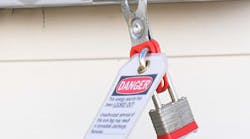A forgotten tool proved to be more than just a minor inconvenience for one unfortunate electrician. Working in a power distribution panel that contained two 500A circuits, the electrician had removed the panel covers for access. Although the load side of the breaker on which he was working was de-energized, the line side of the panel was not. Suddenly, a short circuit occurred, resulting in an arc flash/blast. The electrician, who was not wearing any personal protective equipment except safety glasses, received first- and second-degree burns to his hands and face that required several days of hospitalization.
During a subsequent investigation, a small tool resembling an adapter for operating a socket with a drill was found lodged in a support for the breaker panel. The tool was damaged, indicating it had been involved in the arc flash. The investigation report concluded that the tool likely fell through the panel and came in contact with the energized wires, causing the arc flash. Although it was never definitively found where the tool came from, one possibility is that a previous worker left it behind.
To prevent injuries such as these, the following steps are recommended:
-
Schedule electrical work when the equipment can be completely shut down and de-energized.
-
Establish an “electrically safe work condition” whenever possible. De-energize it, lock it out, ground it, and test it. Turning off a breaker only de-energizes the load side, which does not create an “electrically safe work condition.”
-
If work must be performed on energized equipment, it should be performed under an effective energized work policy meeting requirements in NFPA 70E, 130.1-130.7, 2004.
-
When working on or near energized equipment, always wear appropriate personal protective equipment. This includes a face shield, insulating gown/sleeves, and flame-resistant cothing. Furthermore, use protective insulating shields/barriers between the worker and the energized parts. See NFPA 70E, 2004 for guidelines.
-
Develop a written housekeeping policy. Ensure all workers are trained on the importance of good housekeeping practices. Schedule jobs to allow enough time at the end for cleanup.
-
Use insulated tools for electrical work.
Editor's Note: This electrical safety lesson is based on SHARP Report #85-3-2006, developed by the Safety & Health Assessment & Research for Prevention (SHARP) Program at the Washington State Department of Labor and Industries, Olympia, Wash.



